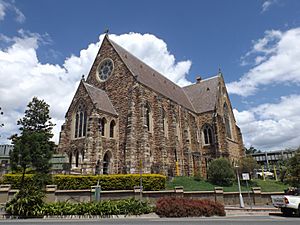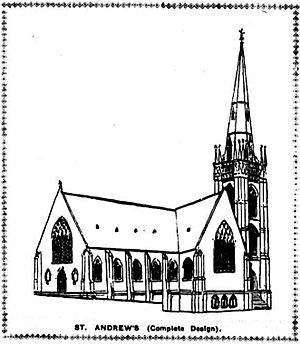St Andrews Anglican Church, South Brisbane facts for kids
Quick facts for kids St Andrews Anglican Church, South Brisbane |
|
|---|---|

St Andrew Anglican Church, 2015
|
|
| Location | 160 Vulture Street, South Brisbane, City of Brisbane, Queensland, Australia |
| Design period | 1870s - 1890s (late 19th century) |
| Built | 1878 - 1932 |
| Architect | Andrea Stombuco |
| Official name: St Andrews Anglican Church | |
| Type | state heritage (built) |
| Designated | 21 October 1992 |
| Reference no. | 600304 |
| Significant period | 1878, 1882-1883, 1887, 1909, 1931-1932 (fabric) |
| Significant components | church, stained glass window/s, furniture/fittings, hall |
| Lua error in Module:Location_map at line 420: attempt to index field 'wikibase' (a nil value). | |
St Andrews Anglican Church is a historic church located at 160 Vulture Street in South Brisbane, Queensland, Australia. It was designed by the famous architect Andrea Stombuco and built over many years, from 1878 to 1932. This beautiful church is so important that it was added to the Queensland Heritage Register on 21 October 1992.
Contents
Building the Church
St Andrew's Anglican Church was built in several steps. This happened because the church needed to raise money over time. Construction took place in 1878-1883, 1887, and again from 1931-1932.
Why a New Church?
The first Anglican church in South Brisbane was St Thomas', built around 1855. But the area grew a lot! More and more people moved to South Brisbane. Also, the first church was in a low area that often flooded. So, people started moving their homes and important buildings to higher ground. This is why a new, bigger church like St Andrew's was needed.
The Original Grand Plan
A talented Italian architect named Andrea Stombuco was chosen to design St Andrew's. He had designed many other important buildings, including churches. Stombuco imagined a very grand church made of stone, with a tall tower and a pointy spire.
The first stone for St Andrew's was laid on 30 November 1878 by the Queensland Governor, Arthur Kennedy. Work began, but it stopped when the walls were only about 6 feet high. Stombuco's design was too expensive for the church at that time.
Completing the Church
Work on the church started again in 1882. The chancel (the area around the altar), the transepts (the parts that stick out on the sides, making the church look like a cross), and the first part of the nave (the main seating area) were finished in 1883. The builder for this part was James O'Keeffe. The church was officially opened on 6 June 1883 by Bishop Matthew Hale. More than 500 people came to the opening!
In 1887, an architect named Hezekiah Watson King Martin designed an extension. He had just moved to Brisbane from London and was an active member of the church.
Other Buildings
In 1887, architect John H. Buckeridge designed the rectory, which is the house where the church's priest lives. He also designed more additions to it in 1892. This rectory was later moved to a different location and is now a private home.
The church also needed a hall for meetings and events. The parish hall was built in 1909. It was designed by architect William Alfred Caldwell.
As the number of church members continued to grow, the rest of the nave was finally completed between 1931 and 1932. This work was overseen by architect Lange Leopold Powell. Even with all these additions, the tall tower and spire that Andrea Stombuco had planned were never built.
What the Church Looks Like
St Andrews is a large church built in the Gothic style. This means it has features like pointed arches and tall windows. It is shaped like a cross (called cruciform) and is made from a type of stone called Brisbane tuff.
Inside and Out
The church has a nave (the main part where people sit) and transepts (the arms of the cross shape). There's also a portico (a porch with columns) at the front and a chancel at the back. These parts have lower roofs than the main nave. A small vestry (a room for the priest to prepare) is on one side of the chancel, and a half-built tower is on the other. The church has a very steep roof made of slate.
One of the most beautiful parts of the church is its large stained glass windows. These are especially stunning at the ends of the chancel, portico, and transepts. They let colorful light stream into the church.
The Church Hall
The timber hall is made of wood. It has a main section surrounded by enclosed verandahs. The main part of the hall has a steeply sloped roof made of corrugated iron. Inside, you can see the beautiful wooden ceiling supported by strong timber trusses.
Why St Andrews is Special
St Andrews Anglican Church is listed on the Queensland Heritage Register because it's a very important historical site. It was added to the list on 21 October 1992.
A Piece of History
The church shows how the Anglican Church grew in Queensland. It also shows how South Brisbane became a busy and important area, just like North Brisbane, in the late 1800s. The church's location also tells us about the past. People built it on higher ground after floods in the 1860s, as more middle-class families moved to areas like South Brisbane and Highgate Hill.
Unique and Beautiful
St Andrew's is a special example of a large, stone Gothic-style church in Brisbane. It has amazing stained glass windows that are truly works of art. It's a well-known landmark in South Brisbane and has been an important part of the city's look for over 100 years. Its beauty and design make it very important.
Community Connection
This church has a strong and special connection with the community. For many years, it has been a place for people to gather for religious, social, and cultural reasons. It holds a special meaning for many people in Queensland.
Architect's Vision
Even though the church was built in different stages over many years (from 1878 to 1932), it still shows a lot of architect Andrea Stombuco's original ideas. It helps us understand his important work and his style of design.


